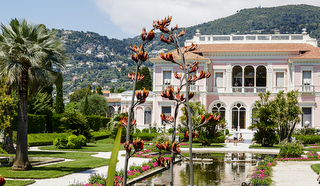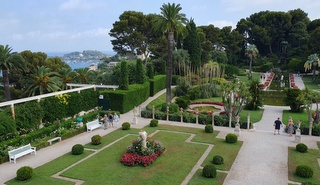Three Gardens to see in Spring
Submitted by HedonisticHiking on 6 Nov 2023
Palazzo Pfanner - Lucca
Lucca is one of Tuscany's gems, encircled by impressive Renaissance walls, and is the first stop on our Lucca, Volterra and Elba tour which runs in May. We have a little stroll around the 4 km walls as we arrive into the town, and this beautiful elevated promenade offers great views of the city. From the northern side of the walls you can see into the garden of one of the most important palazzos - the Palazzo Pfanner - nestled between the churches of Sant' Agostino and San Frediano. The house was built by a wealthy merchant in the middle of the 1600s. The Baroque garden was first designed and laid out in the early part of the 18th century. The name Pfanner came from a Bavarian family who rented space in the gardens in the mid 1800s to set up Lucca's first German-style brewery. Customers of the brewery would enjoy their beer in the peaceful natural surroundings of the garden. With greater prosperity the Pfanner family were eventually able to buy the whole Palazzo as well as the gardens and it is still owned by them today, although brewing ceased in 1929. The Baroque garden is set with statues, fountains, box and laurel hedges and through the seasons magnolias, peonies, hydrangeas, camellias, roses and geraniums all come into bloom. There are dozens of antique earthenware vases for lemon trees, which would be housed in the Limonaia at the north end of the garden over the winter months. It has been used as the setting for many films including Portrait of a Lady starring Nicole Kidman.
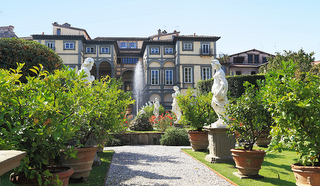
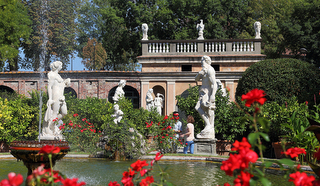
La Foce - Tuscany
The south of Siena is a sparsely populated landscape of clay hills, known as Le Crete. The Orcia river cuts across the landscape and the Val d'Orcia remains one of the most beautiful and untouched valleys in Southern Tuscany. The garden we visit here each May belongs to the villa known as La Foce, a word which translates as the mouth of a river. The Villa itself was built in the late 15th century as a hostel for pilgrims and merchants travelling between Florence and Rome. In 1924 it was lived in by Antonio Origo and his English/American wife Iris, a famous biographer and writer. They poured much of their energy into developing the garden and the land around it, with the help of English architect Cecil Pinsent. The gardens today represent a harmonious blending of Italian and English traditions and tastes.The formal Italian garden is all geometric lines and rigid box hedges but stroll up to the rose garden and you’ll find lavender hedges and an impressive wisteria-covered pergola and, beyond that, cherry trees and cypresses set amongst a carpet of aromatic thyme and rosemary. Guests on our Etruscan Trails in Central Italy tour often feel that the most magnificent feature of this garden is the strikingly beautiful view beyond the garden's boundary across the Orcia Valley to Monte Amiata on the horizon. During the war the couple sheltered refugee children and aided Allied POWs. Iris's novel War in the Val d'Orcia is a first-hand account of daily life in southern Tuscany during the final years of the second World War and is highly recommended.
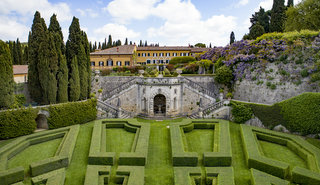
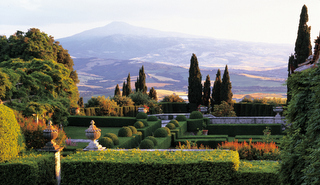
Villa Ephrussi de Rothschild - Cap Ferrat
New for 2024 is our updated itinerary for France and the Maritime Alps. This Level 5 hike runs in June. It starts in Nice and we hike over the border into Italy and finish in the elegant town of Cuneo. Before leaving the Cote d'Azur we visit the splendid gardens of the Villa Ephrussi de Rothschild at Cap Ferrat. The villa and its land were developed in the early 1900s by Béatrice de Rothschild, one of the wealthiest heiresses in Europe and an avid collector of fine porcelain, furniture and paintings by the Great Masters. She threw herself into this project following her divorce from Maurice Ephrussi, a Parisian banker of Russian origin, to whom she had been unhappily married for 21 years. A serious illness contracted from him prevented her from having children. The French garden was designed to represent the deck of a ship, as the sea is visible on both sides, and is decorated with waterfalls, ornamental ponds, olive trees, cypress hedges and Aleppo pines. But there is much more to explore: nine gardens in all including a Spanish garden, a Japanese garden, a Stone garden, an Exotic garden and a Rose garden, with hundreds of varieties in bloom from May to July. In 1933, a year before her death, Béatrice bequeathed her Villa, its lands and the entirety of its collections to the French Académie des Beaux-Arts. Still today they manage and maintain this extraordinary residence.
